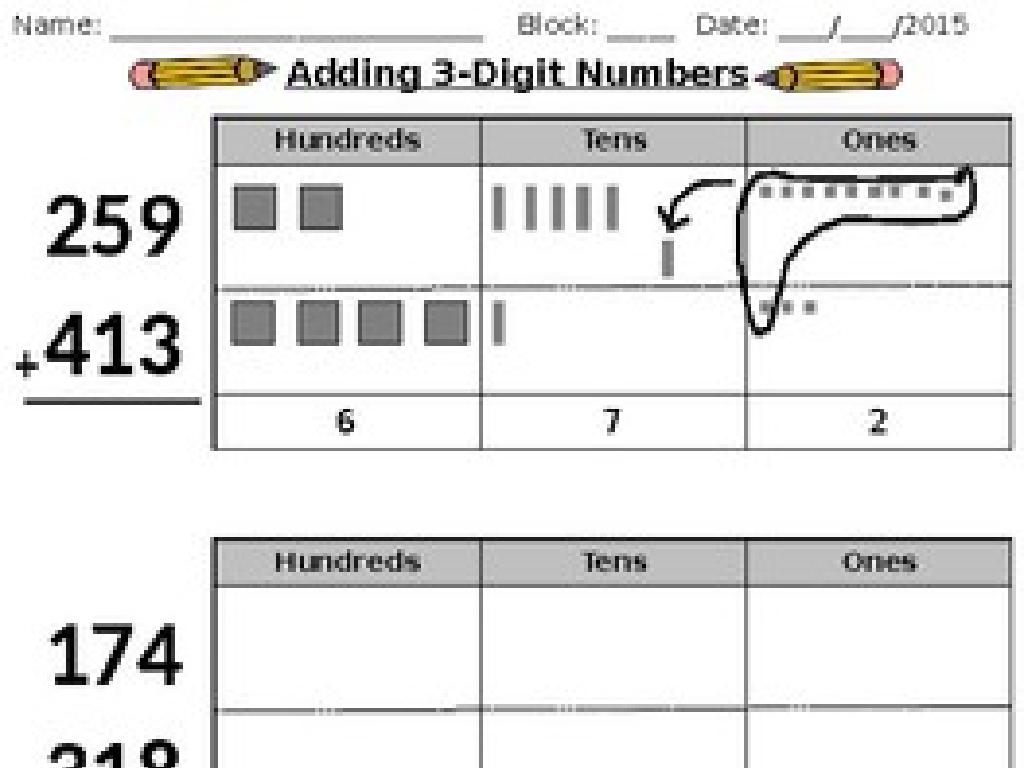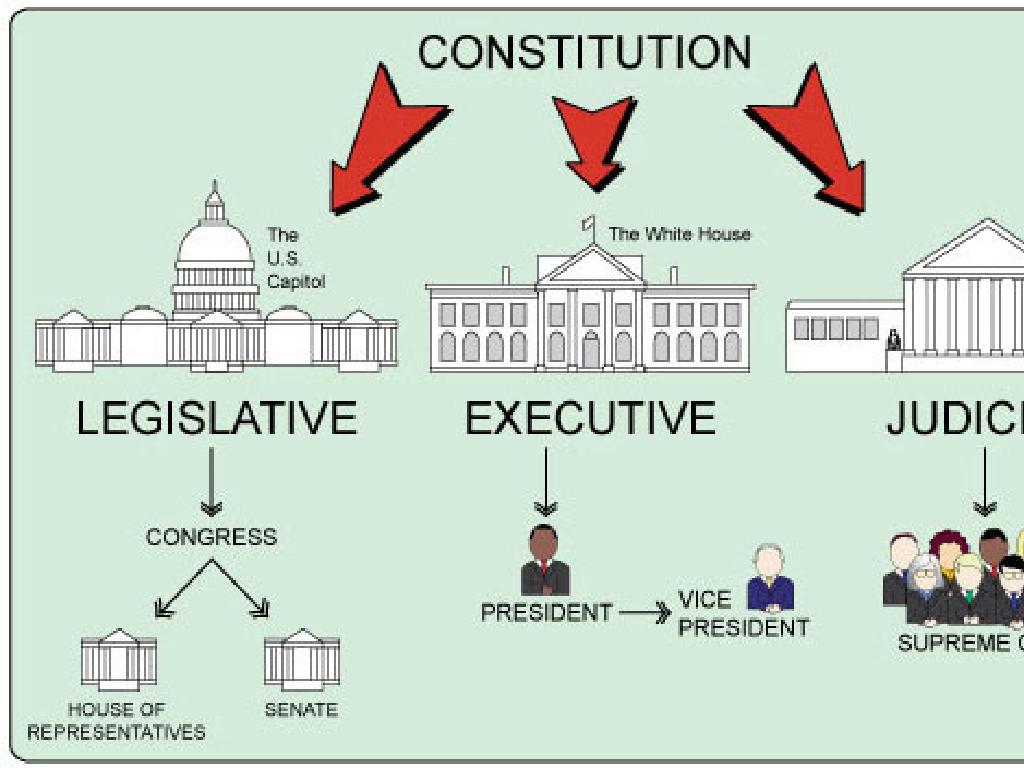The Greenhouse Effect
Subject: Science
Grade: Eighth grade
Topic: The Greenhouse Effect
Please LOG IN to download the presentation. Access is available to registered users only.
View More Content
The Greenhouse Effect: Earth’s Atmospheric Blanket
– Explore Earth’s atmospheric layers
– Layers include the troposphere, stratosphere, mesosphere, and thermosphere.
– The Greenhouse Effect explained
– Greenhouse gases trap heat, warming the Earth.
– Its role in sustaining life
– Without it, Earth would be too cold for life.
– Balancing the Greenhouse Effect
– Excess greenhouse gases can lead to global warming.
|
Begin the class by introducing the different layers of Earth’s atmosphere, emphasizing the troposphere where the Greenhouse Effect occurs. Explain how greenhouse gases like carbon dioxide and methane trap heat from the sun, creating a warm environment that sustains life. Highlight the importance of this natural process in maintaining the planet’s average temperature. Discuss the delicate balance required to keep the Greenhouse Effect beneficial without tipping into excessive global warming, which can have detrimental effects on our climate and ecosystems. Encourage students to think about how human activities contribute to this balance.
Understanding the Greenhouse Effect
– Define the Greenhouse Effect
– The warming of Earth’s surface due to trapped heat
– Natural vs. Enhanced Effect
– Natural occurs for Earth’s warmth, Enhanced by human activities
– Role of CO2 and Methane
– These gases trap heat, increasing Earth’s temperature
– Impact on Earth’s Climate
|
The Greenhouse Effect is a natural process that warms the Earth’s surface. When the Sun’s energy reaches the Earth’s atmosphere, some of it is reflected back to space and the rest is absorbed and re-radiated by greenhouse gases. The absorbed energy warms the atmosphere and the surface of the Earth. This slide will explain the difference between the natural greenhouse effect, which makes life possible, and the enhanced greenhouse effect, which is caused by an increase in greenhouse gases like CO2 and Methane due to human activities such as burning fossil fuels and deforestation. This leads to global warming and climate change. It’s crucial for students to understand the impact of these gases on Earth’s climate and the importance of taking action to reduce emissions.
How Does the Greenhouse Effect Work?
– Sunlight interacts with Earth’s surface
– Earth absorbs some solar energy and reflects the rest.
– Greenhouse gases and heat retention
– Gases like CO2 trap heat, warming the planet.
– Understanding Earth’s energy budget
– Energy budget: the equilibrium of absorbed and emitted energy.
– The balance of energy: crucial for climate
|
This slide aims to explain the mechanisms behind the greenhouse effect. Begin with how sunlight reaches Earth, with some energy absorbed and some reflected back into space. Discuss the role of greenhouse gases like carbon dioxide and methane in trapping heat in the atmosphere, leading to a warming effect. Explain the concept of Earth’s energy budget, which is the balance between the energy Earth receives from the Sun and the energy it radiates back into space. Emphasize the importance of this balance in maintaining Earth’s climate and how the greenhouse effect can disrupt this balance, leading to climate change. Provide examples and encourage students to think about how human activities might influence greenhouse gas concentrations.
The Importance of the Greenhouse Effect
– Sustains Earth’s temperatures
– Keeps Earth warm enough to support life.
– Greenhouse Effect vs. Global Warming
– Greenhouse Effect is natural, Global Warming is the excessive effect due to human activities.
– Daily life examples
– Car windows trapping heat, similar to how Earth’s atmosphere works.
– Balance is crucial for life
|
This slide aims to educate students on the critical role the Greenhouse Effect plays in maintaining life-sustaining temperatures on Earth. It’s essential to differentiate between the natural Greenhouse Effect and the enhanced effect leading to Global Warming, which is exacerbated by human activities such as burning fossil fuels. Provide relatable examples, such as how heat is trapped inside a car on a sunny day, to illustrate the concept. Emphasize the importance of balance in the Greenhouse Effect to prevent adverse effects on our planet’s climate and ecosystems. Encourage students to think about how their actions impact the environment and discuss ways to reduce their carbon footprint.
Human Impact on the Greenhouse Effect
– Fossil fuels boost greenhouse gases
– Burning coal, oil, and gas adds CO2 to the atmosphere.
– Deforestation raises CO2 levels
– Trees absorb CO2; fewer trees mean more CO2 remains in the air.
– Agriculture’s role in emissions
– Farming activities produce methane, a potent greenhouse gas.
– Mitigating human impact
– Reducing emissions can slow the greenhouse effect.
|
This slide aims to educate students on how human activities contribute to the greenhouse effect. Discuss how the combustion of fossil fuels for energy releases a significant amount of carbon dioxide, a primary greenhouse gas. Explain deforestation’s impact on carbon dioxide levels, as trees play a crucial role in absorbing CO2. Highlight how certain agricultural practices result in the release of methane, another greenhouse gas. Emphasize the importance of taking action to reduce human-induced greenhouse gas emissions, such as using renewable energy sources, reforestation, and sustainable farming practices. Engage students by discussing how they can contribute to mitigating the greenhouse effect in their daily lives.
Consequences of Enhanced Greenhouse Effect
– Global warming and climate change
– Increased temperatures affecting weather and climate systems
– Rising sea levels and extreme weather
– Melting ice caps leading to higher sea levels and more natural disasters
– Impact on biodiversity and ecosystems
– Loss of species and habitats, disrupting ecological balance
– Mitigation and adaptation strategies
– Implementing policies to reduce emissions and protect the environment
|
This slide aims to educate students on the serious consequences of the enhanced greenhouse effect. Global warming refers to the Earth’s rising surface temperature, which contributes to broader climate changes affecting weather patterns, ocean currents, and seasons. Rising sea levels, caused by melting polar ice, pose a threat to coastal communities and can lead to more frequent and severe weather events like hurricanes and floods. Biodiversity loss is another critical issue, as many species cannot adapt quickly enough to the changing environment, leading to disrupted ecosystems. It’s crucial to discuss how we can mitigate these effects through reducing greenhouse gas emissions and how we can adapt to changes that are already underway. Encourage students to think about how these changes might affect their own lives and what actions they can take to help.
Mitigating the Enhanced Greenhouse Effect
– Reduce individual carbon footprint
– Walk more, waste less, recycle, and plant trees.
– Embrace renewable energy sources
– Solar, wind, hydro, and geothermal power as alternatives.
– Improve energy efficiency
– Use LED bulbs, insulate homes, and smart thermostats.
– Support international green policies
– Paris Agreement aims to reduce global greenhouse gas emissions.
|
This slide aims to educate students on the actions they can take to mitigate the enhanced greenhouse effect. Emphasize the power of individual actions such as reducing waste and increasing recycling efforts. Discuss renewable energy sources like solar and wind power as sustainable alternatives to fossil fuels. Highlight the importance of energy efficiency in daily life through simple changes like using LED lighting. Finally, explain the role of international agreements, such as the Paris Agreement, in uniting countries towards a common goal of reducing greenhouse gas emissions. Encourage students to think globally and act locally, understanding that their actions contribute to a larger effort against climate change.
Class Activity: Greenhouse Simulation
– Construct a mini-greenhouse
– Observe heat retention
– Use thermometers to measure temperature changes inside and outside the greenhouse
– Compare different conditions
– Test with varying amounts of insulation or different materials
– Discuss reducing impact
– Brainstorm ways to lessen our greenhouse gas emissions
|
This activity is designed to give students a hands-on understanding of the greenhouse effect. Students will create their own mini-greenhouses using transparent plastic containers and measure how well they retain heat in different conditions, such as with varying amounts of insulation or using different materials. Provide students with thermometers to record temperature changes. After the experiment, lead a discussion on the implications of their observations and how the greenhouse effect relates to global warming. Encourage them to think about actions that can be taken to reduce our impact on the environment, such as conserving energy, planting trees, and reducing waste. Possible activities: 1) Building greenhouses with different base materials, 2) Using various types of insulation, 3) Measuring temperature at different intervals, 4) Comparing results with a control setup, 5) Researching real-world applications of their findings.





